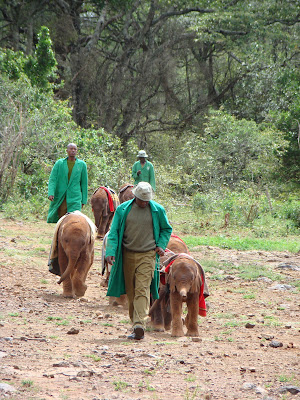
We woke up early this morning to get a jump start on wine tasting -- that's right, the vineyards open at 9am. After consulting with the owner here at Cotswold House, we ended up booking a guide who she referred to as "her guy." Our motivations for this decision were twofold:
1 -- With a guide, neither of us needed to drive, guaranteeing that there would be no more run ins with Cape Town's finest.
2 -- A guide would also guarantee that we got the inside scoop
Our guide, Charles (Charlos) was awesome and is highly recommended for anyone planning a trip here (
www.charlostours.co.za).

Charlos picked us up from the B&B and we were on our way east towards
Stellenbosch, one of the three major growing regions in the cape winelands. The first vineyard we visited was
Spier, and it was definitely the most "touristy." We didn't do any tasting here, however we did tour the gardens and terraces and we DID get to see a cheetah. Did you know that there are only 7500 cheetahs left in the world and that they purr REALLY loudly??
The organization keeping the cheetahs also breeds Anatolian shepherds to give to local farmers. These shepherds scare cheetahs away, protecting livestock from the cats, and ultimately the cheetahs themselves from irate farmers with guns. We saw a couple of the shepherds...we would most certainly NOT mess with them.
Ok, enough of the wildlife lesson and on to the wine! Our first tasting was at
Rustenberg. Here's Roland, who guided us through their vintages:

Roland helped select three whites and three reds for us to try including a Roussanne, Sauvignon Blanc, Chenin Blanc, OVR, Bordeaux Blend, and Cabernet. The apricot, peach and guava scents in the whites were really unique. We meandered through the gardens on our way back to the car and were soon on our way to the next stop, Tokara.
Tokara is a very young and modern looking vineyard that also specializes in olive production. We sampled mostly sauvignon blanc and chardonnays here but the olive pairings added a different twist. Six more wines, 6 olives and some olive paste later and we were on our way. I opted to pass on the brandy tasting.
We continued on through Stellenbosch to Boschendal vineyards where we had lunch at
an outdoor cafe. We skipped the cellar tour and tasting here, instead trekking north out of the Stellenbosch region into the town of Paarl - another well known wine region. With a check of our clock and strategic planning to maximize our vineyard visits before closing time, we headed to
Fairview. We were surprised to discover this is the vineyard that makes "Goats Do Roam" a wine label that we've purchased in the US and were first introduced to by a South African while on a ranch in Wyoming. We also paired these six tastings (including viognier, a white wine we'd never heard of before)with cheeses made at the estate.

We enjoyed everything from cranberry infused blue cheese to a smooth Havarti and also some really tasty Camembert and brie cheeses. Back to the car and the onto
Seidelberg Wine Estate. We toured the cellar and learned about the picking process as well pressing, fermenting, and bottling. Walking through the giant vats and seeing the open containers of juice absolutely gave us a new appreciation for the complexities of wine production. Back inside, we sampled a pinotage, a Syrah and chardonnay among others.
As the clouds rolled in, we decided to call it a day after six vineyards and four tastings. Charlos returned us to Cotswald House where we headed upstairs and promptly fell asleep. Another hard day in South Africa. Tomorrow, if the weather cooperates, we'll be heading up Table Mountain and meeting up with our Gecko Tours group for dinner. The 60 day safari begins!





































